The Skills of Medium-Range Precipitation Forecasts in the Senegal River Basin
Abstract
:1. Introduction
- (1)
- What is the skill of the 1-day lead, daily, GFS forecasts?
- (2)
- How does the skill vary with lead time and temporal aggregation scale?
- (3)
- How does the performance of a near-real time satellite-only product, IMERG Early, compare with the performance of GFS?
2. Data and Methodology
2.1. Data
2.2. Methodology
3. Results and Discussion
3.1. Annual Spatial Variability of Rainfall
3.2. Monthly Cycle of Rainfall
3.3. Annual Rainfall
3.4. Daily Time Series
3.5. KGE Statistics
3.6. Dependence of Forecast Performance on Precipitation Rate
3.7. Effect of Lead Time on Forecast Performance
3.8. Effect of Temporal Aggregation Scale on Forecast Performance
3.9. Comparison of the Performances of IMERG Early and GFS
3.10. Performance of GFS If the Reference Product Is Changed from IMERG Final to CHIRPS
4. Conclusions
Author Contributions
Funding
Data Availability Statement
Conflicts of Interest
References
- Pandya, R.; Hodgson, A.; Hayden, M.H.; Akweongo, P.; Hopson, T.; Forgor, A.A.; Yoksas, T.; Dalaba, M.A.; Dukic, V.; Mera, R.; et al. Using weather forecasts to help manage meningitis in the West African Sahel. Bull. Am. Meteorol. Soc. 2015, 96, 103–115. [Google Scholar] [CrossRef]
- Koppa, A.; Gebremichael, M.; Zambon, R.C.; Yeh, W.W.G.; Hopson, T.M. Seasonal Hydropower Planning for Data-Scarce Regions Using Multimodel Ensemble Forecasts, Remote Sensing Data, and Stochastic Programming. Water Resour. Res. 2019, 55, 8583–8607. [Google Scholar] [CrossRef]
- Alexander, S.; Yang, G.; Addisu, G.; Block, P. Forecast-informed reservoir operations to guide hydropower and agriculture allocations in the Blue Nile basin, Ethiopia. Int. J. Water Resour. Dev. 2021, 37, 208–233. [Google Scholar] [CrossRef]
- National Centers for Environmental Prediction/National Weather Service/NOAA/U.S. Department of Commerce. NCEP GFS 0.25 Degree Global Forecast Grids Historical Archive. Research Data Archive at the National Center for Atmospheric Research, Computational and Information Systems Laboratory. 2015. Available online: https://rda.ucar.edu/datasets/ds084.1/ (accessed on 11 March 2022).
- Saha, S.; Moorthi, S.; Wu, X.; Wang, J.; Nadiga, S.; Tripp, P.; Behringer, D.; Hou, Y.-T.; Chuang, H.-Y.; Iredell, M.; et al. The NCEP climate forecast system version 2. J. Clim. 2014, 27, 2185–2208. [Google Scholar] [CrossRef]
- Dutra, E.; Diamantakis, M.; Tsonevsky, I.; Zsoter, E.; Wetterhall, F.; Stockdale, T.; Richardson, D.; Pappenberger, F. The extreme forecast index at the seasonal scale. Atmosph. Sci. Lett. 2013, 14, 256–262. [Google Scholar] [CrossRef]
- JMA. Outline of the Operational Numerical Weather Prediction at the Japan Meteorological Agency (Appendix to WMO Numerical Weather Prediction Progress Report). Japan Meteorological Agency, 47p. 2019. Available online: https://www.jma.go.jp/jma/jma-eng/jma-center/nwp/outline2019-nwp/index.htm (accessed on 11 March 2022).
- Yue, H.; Gebremichael, M.; Nourani, V. Performance of the global forecast system’s medium-range precipitation forecasts in the Niger River Basin. Hydrol. Earth Syst. Sci. 2021, 2021, 1–31. [Google Scholar] [CrossRef]
- Dezfuli, A.K.; Ichoku, C.M.; Huffman, G.J.; Mohr, K.I.; Selker, J.S.; Van De Giesen, N.; Hochreutener, R.; Annor, F.O. Validation of IMERG precipitation in Africa. J. Hydrometeorol. 2017, 18, 2817–2825. [Google Scholar] [CrossRef] [PubMed]
- Dezfuli, A.K.; Ichoku, C.M.; Mohr, K.I.; Huffman, G.J. Precipitation characteristics in West and East Africa from satellite and in situ observations. J. Hydrometeorol. 2017, 18, 1799–1805. [Google Scholar] [CrossRef]
- Gossett, M.; Alcoba, M.; Roca, R.; Cloche, S.; Urbani, G. Evaluation of TAPEER daily estimates and other GPM-era products against dense gauge networks in West Africa, analysing ground reference uncertainty. Q. J. R. Meteorol. Soc. 2018, 144, 255–269. [Google Scholar] [CrossRef] [Green Version]
- Satgé, F.; Defrance, D.; Sultan, B.; Bonnet, M.P.; Seyler, F.; Rouché, N.; Paturel, J.E. Evaluation of 23 gridded precipitation datasets across West Africa. J. Hydrol. 2020, 581, 124412. [Google Scholar] [CrossRef] [Green Version]
- Maranan, M.; Fink, A.H.; Knippertz, P.; Amekudzi, L.K.; Atiah, W.A.; Stengel, M. A process-based validation of GPM IMERG and its sources using a mesoscale rain gauge network in the West African forest zone. J. Hydrometeorol. 2020, 21, 729–749. [Google Scholar] [CrossRef]
- Gaye, C.B.; Diaw, M.; Malou, R. Assessing the impacts of climate change on water resources of a West African trans-boundary river basin and its environmental consequences (Senegal River Basin). Sci. Cold Arid. Reg. 2013, 5, 0140–0156. [Google Scholar] [CrossRef]
- Djaman, K.; Balde, A.B.; Rudnick, D.R.; Ndiaye, O.; Irmak, S. Long-term trend analysis in climate variables and agricultural adaptation strategies to climate change in the Senegal River Basin. Int. J. Clim. 2017, 37, 2873–2888. [Google Scholar] [CrossRef]
- Huffman, G.J.; Stocker, E.F.; Bolvin, D.T.; Nelkin, E.J.; Jackson, J. GPM IMERG Final Precipitation L3 1 Day 0.1 Degree x 0.1 Degree V06; Savtchenko, A., Ed.; Goddard Earth Sciences Data and Information Services Center (GES DISC): Greenbelt, MD, USA, 2019. [CrossRef]
- Huffman, G.J.; Stocker, E.F.; Bolvin, D.T.; Nelkin, E.J.; Jackson, J. GPM IMERG Early Precipitation L3 1 Day 0.1 Degree x 0.1 Degree V06; Savtchenko, A., Ed.; Goddard Earth Sciences Data and Information Services Center (GES DISC): Greenbelt, MD, USA, 2019. [CrossRef]
- Funk, C.; Peterson, P.; Landsfeld, M.; Pedreros, D.; Verdin, J.; Shukla, S.; Husak, G.; Rowland, J.; Harrison, L.; Hoell, A.; et al. The climate hazards infrared precipitation with stations—A new environmental record for monitoring extremes. Sci. Data 2015, 2, 150066. [Google Scholar] [CrossRef] [PubMed] [Green Version]
- Gupta, H.V.; Kling, H.; Yilmaz, K.K.; Martinez, G.F. Decomposition of the mean squared error and NSE performance criteria: Implications for improving hydrological modelling. J. Hydrol. 2009, 377, 80–91. [Google Scholar] [CrossRef] [Green Version]
- Kling, H.; Fuchs, M.; Paulin, M. Runoff conditions in the upper Danube basin under an ensemble of climate change scenarios. J. Hydrol. 2012, 424, 264–277. [Google Scholar] [CrossRef]
- Towner, J.; Cloke, H.I.; Zsoter, E.; Flamig, Z.; Hoch, J.M.; Bazo, J.; de Perez, E.C.; Stephens, E.M. Assessing the performance of global hydrological models for capturing peak river flows in the Amazon basin. Hydrol. Earth Syst. Sci. 2019, 23, 3057–3080. [Google Scholar] [CrossRef] [Green Version]
- Shahid, M.; Rahman, K.U.; Haider, S.; Gabriel, H.F.; Khan, A.K.; Pham, Q.B.; Mohammadi, B.; Linh, N.T.T.; Anh, D.T. Assessing the potential and hydrological usefulness of the CHIRPS precipitation dataset over a complex topography in Pakistan. Hydrol. Sci. J. 2021, 66, 1664–1684. [Google Scholar] [CrossRef]
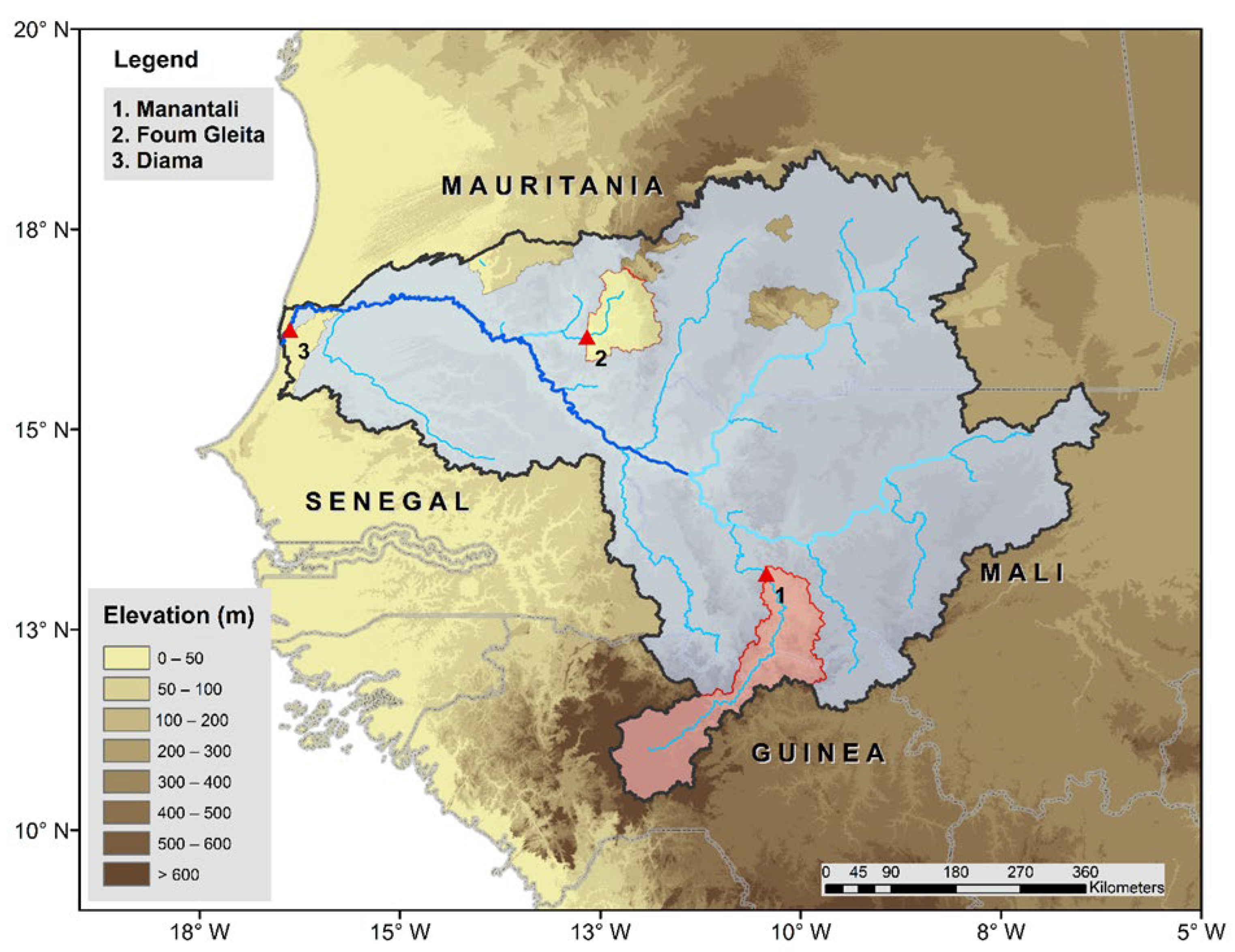

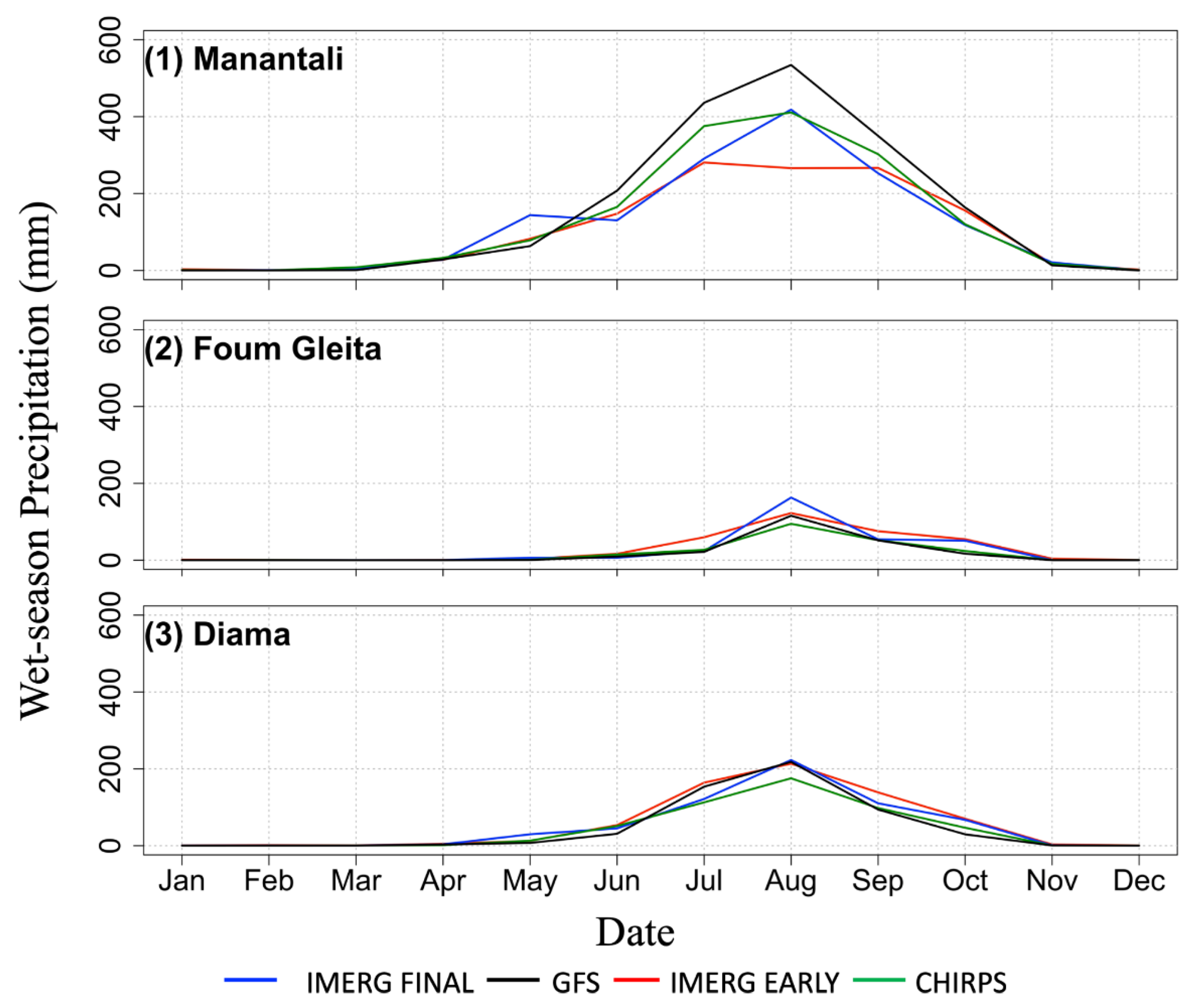
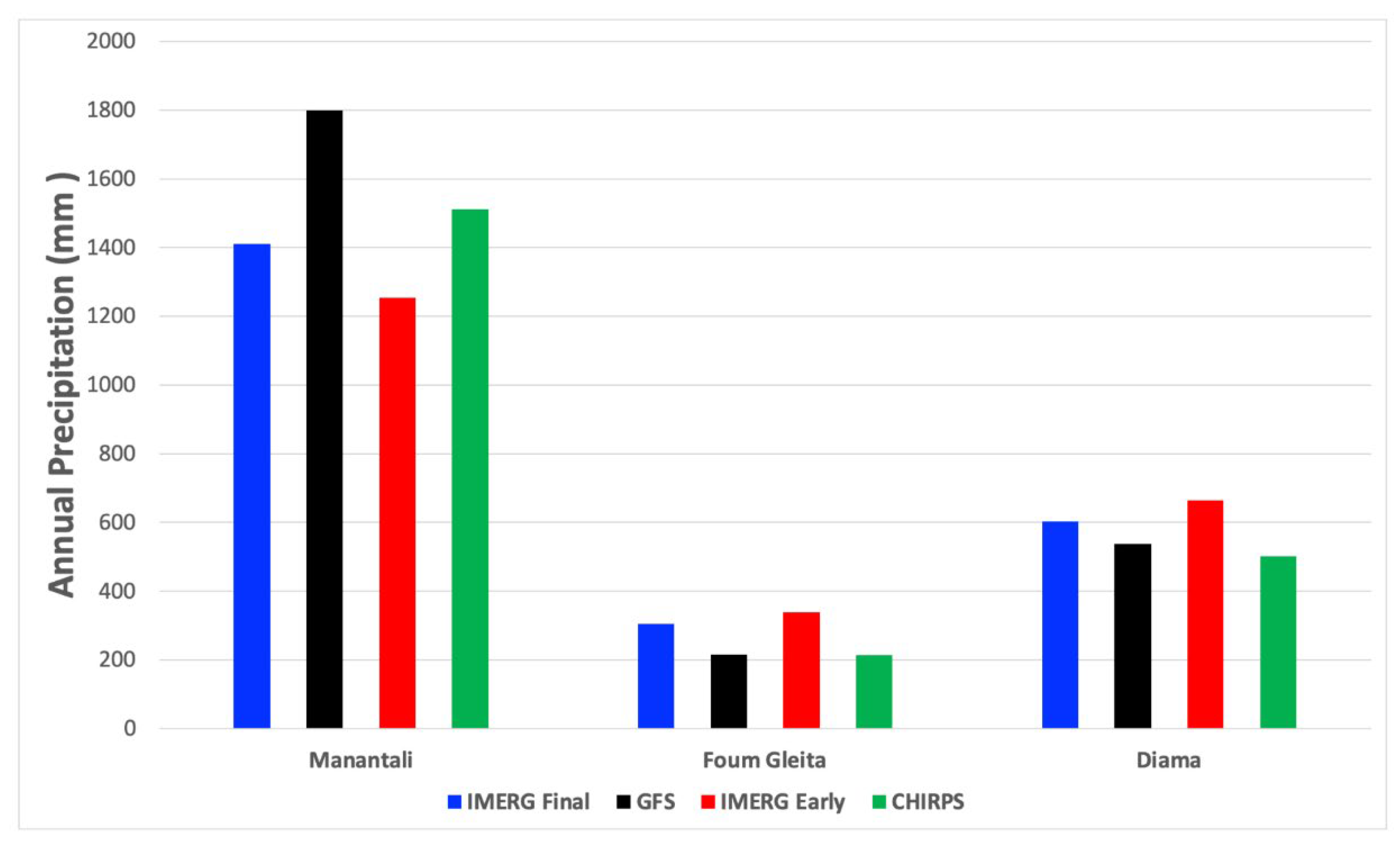

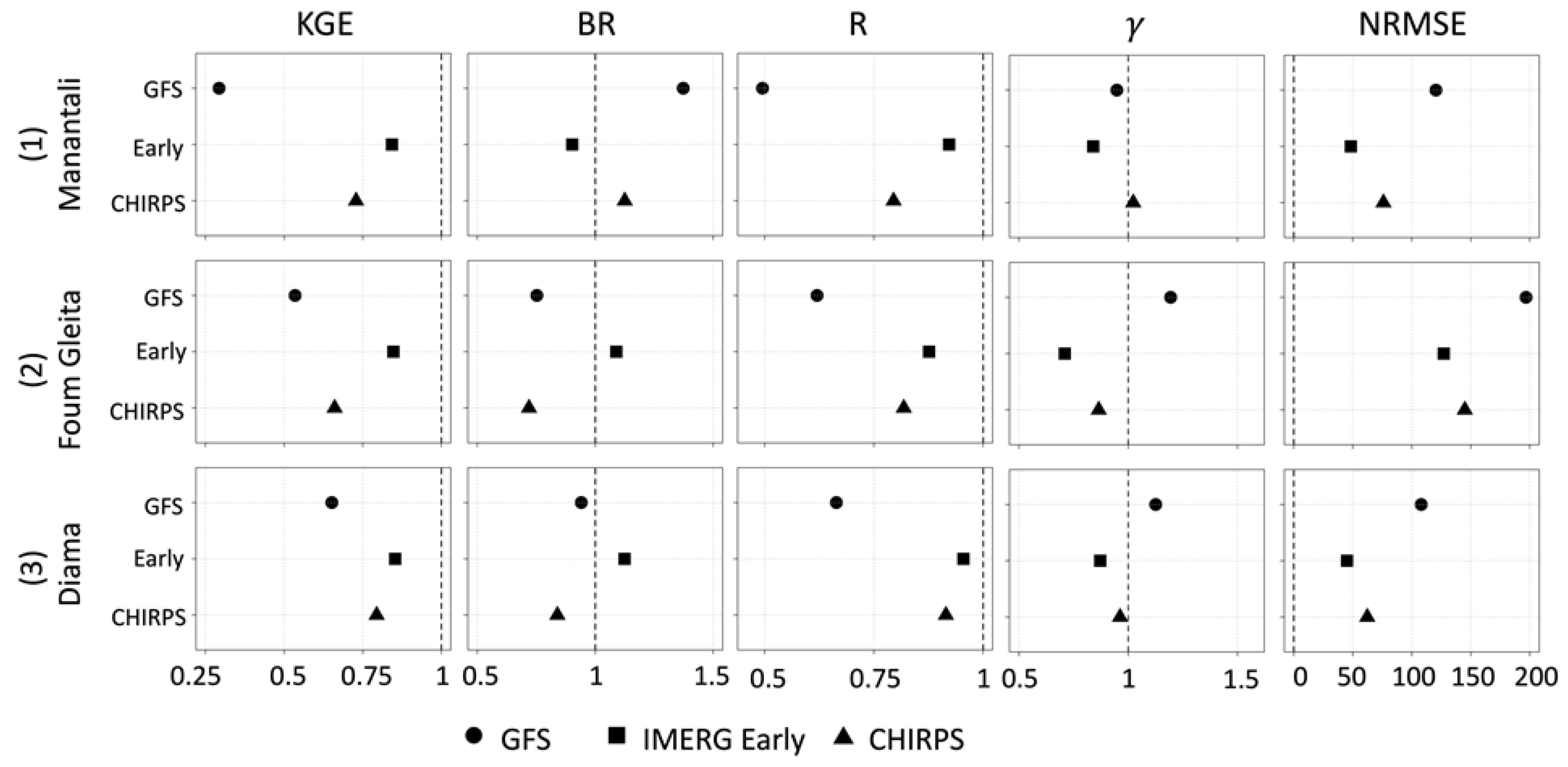

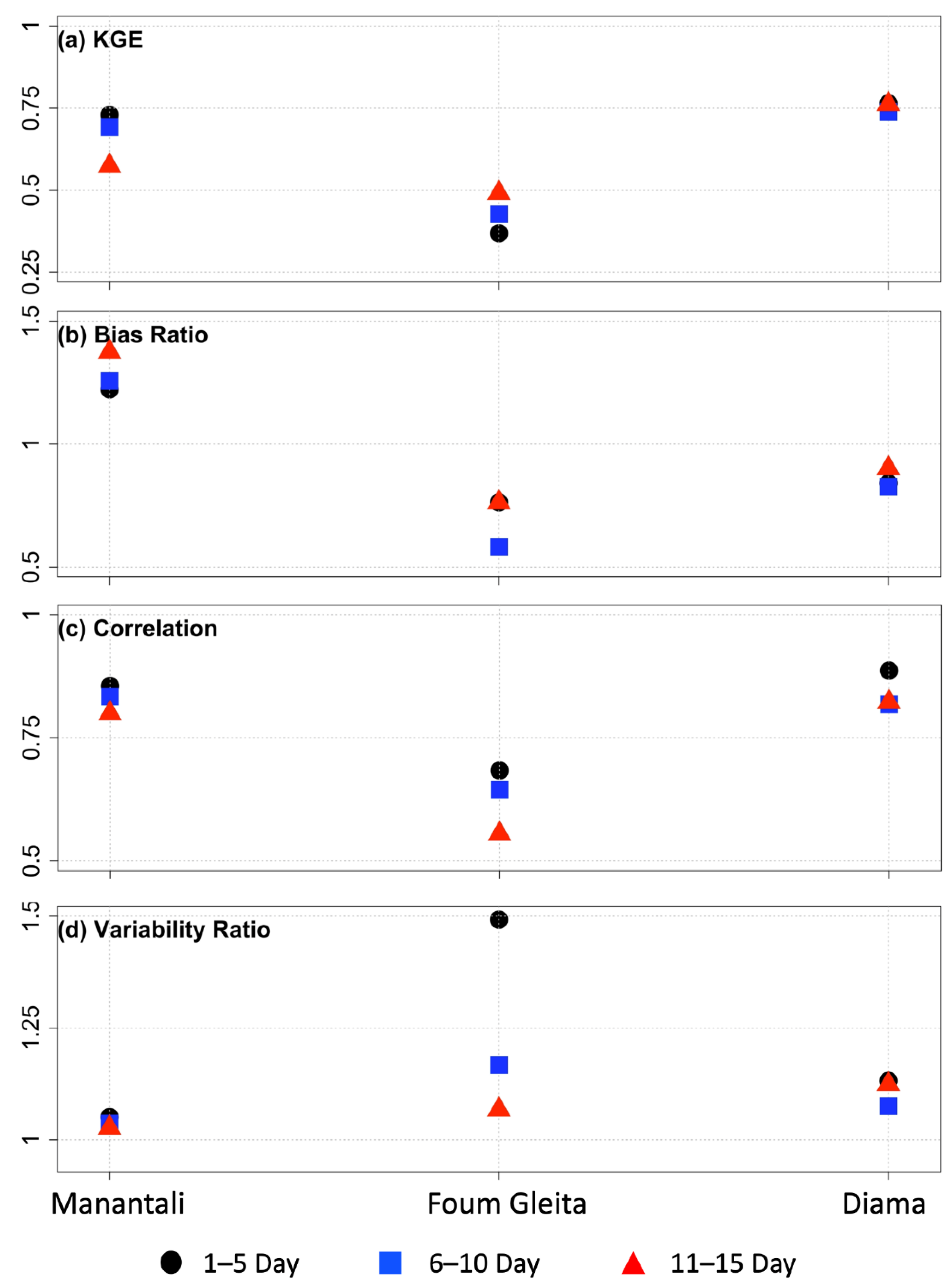
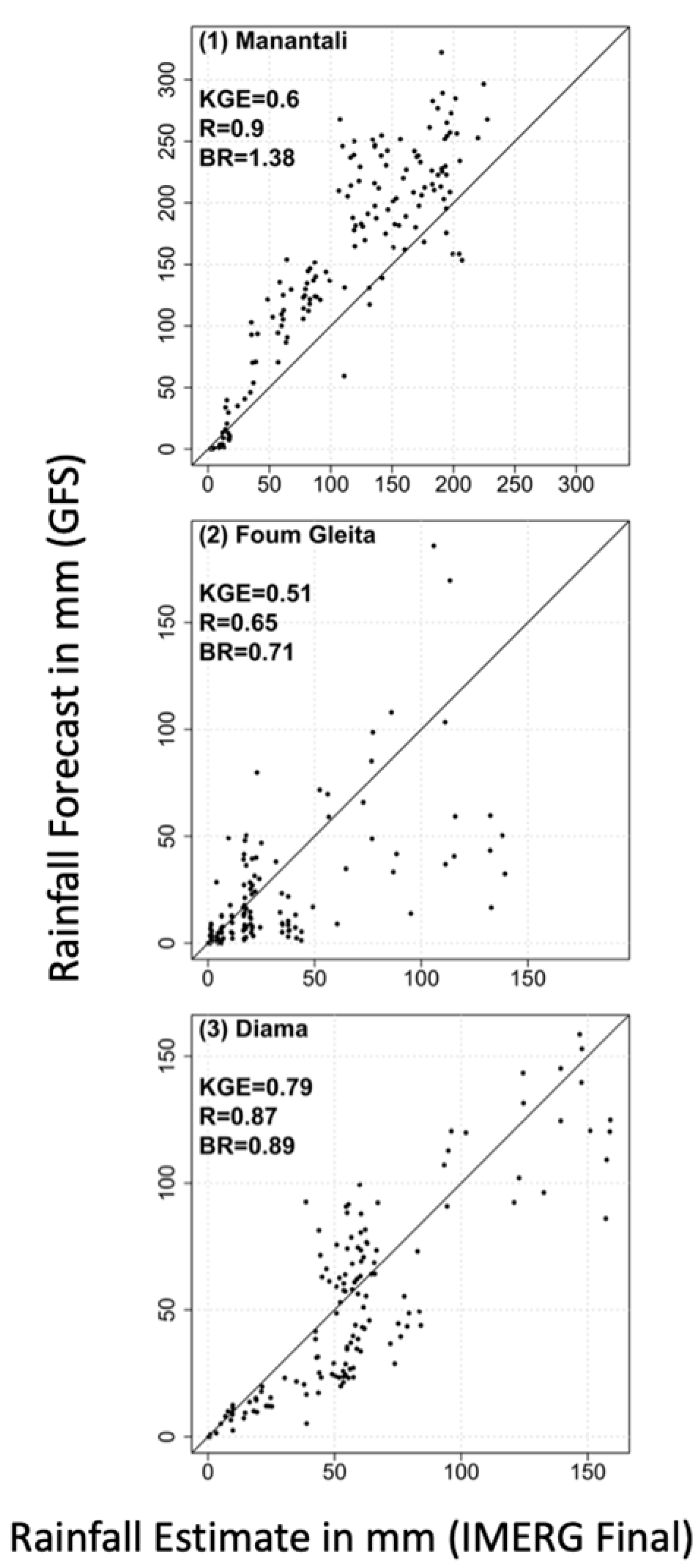
| Dams | Country | Operational Since | Capacity (Million m3) | Power (MW) | Purpose | Area of Drainage Basin (km2) | Elevation of Drainage Basin (m) | |
|---|---|---|---|---|---|---|---|---|
| Irrigation | Hydroelectricity | |||||||
| Manantali | Mali | 1988 | 11,270 | 104 | x | x | 29,340 | 560 |
| Foum Gleita | Mauritania | 1988 | 500 | x | 9513 | 128 | ||
| Diama | Senegal | 1986 | 250 | x | 43,1603 | 199 | ||
| Lead Time of GFS Forecast | Correlation | Bias Ratio | KGE | NRMSE (%) |
|---|---|---|---|---|
| Manantali | ||||
| 1-day | 0.50 (0.56) | 1.37 (1.22) | 0.29 (0.46) | 120 (96) |
| 5-day | 0.43 (0.44) | 1.22 (1.09) | 0.31 (0.39) | 119 (102) |
| 10-day | 0.23 (0.41) | 1.39 (1.24) | 0.07 (0.31) | 145 (111) |
| 15-day | 0.09 (0.20) | 1.61 (1.44) | -0.13 (0.07) | 184 (150) |
| Foum Gleita | ||||
| 1-day | 0.62 (0.58) | 0.75 (1.05) | 0.53 (0.55) | 197 (234) |
| 5-day | 0.34 (0.44) | 0.67 (0.93) | 0.06 (0.12) | 287 (327) |
| 10-day | 0.22 (0.29) | 0.78 (1.08) | 0.19 (0.28) | 273 (295) |
| 15-day | 0.42 (0.30) | 0.70 (0.97) | 0.33 (0.27) | 238 (293) |
| Diama | ||||
| 1-day | 0.66 (0.68) | 0.94 (1.12) | 0.65 (0.66) | 108 (109) |
| 5-day | 0.60 (0.67) | 0.81 (0.96) | 0.55 (0.65) | 116 (105) |
| 10-day | 0.36 (0.44) | 0.94 (1.12) | 0.34 (0.42) | 144 (137) |
| 15-day | 0.31 (0.30) | 0.93 (1.10) | 0.30 (0.29) | 148 (153) |
Publisher’s Note: MDPI stays neutral with regard to jurisdictional claims in published maps and institutional affiliations. |
© 2022 by the authors. Licensee MDPI, Basel, Switzerland. This article is an open access article distributed under the terms and conditions of the Creative Commons Attribution (CC BY) license (https://creativecommons.org/licenses/by/4.0/).
Share and Cite
Gebremichael, M.; Yue, H.; Nourani, V.; Damoah, R. The Skills of Medium-Range Precipitation Forecasts in the Senegal River Basin. Sustainability 2022, 14, 3349. https://doi.org/10.3390/su14063349
Gebremichael M, Yue H, Nourani V, Damoah R. The Skills of Medium-Range Precipitation Forecasts in the Senegal River Basin. Sustainability. 2022; 14(6):3349. https://doi.org/10.3390/su14063349
Chicago/Turabian StyleGebremichael, Mekonnen, Haowen Yue, Vahid Nourani, and Richard Damoah. 2022. "The Skills of Medium-Range Precipitation Forecasts in the Senegal River Basin" Sustainability 14, no. 6: 3349. https://doi.org/10.3390/su14063349
APA StyleGebremichael, M., Yue, H., Nourani, V., & Damoah, R. (2022). The Skills of Medium-Range Precipitation Forecasts in the Senegal River Basin. Sustainability, 14(6), 3349. https://doi.org/10.3390/su14063349








